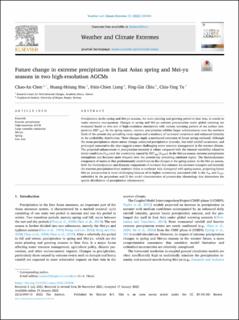| dc.contributor.author | Chen, Chao-An | |
| dc.contributor.author | Hsu, Huang-Hsiung | |
| dc.contributor.author | Liang, Hsin-Chien | |
| dc.contributor.author | Chiu, Ping-Gin | |
| dc.contributor.author | Tu, Chia-Ying | |
| dc.date.accessioned | 2022-06-09T06:40:06Z | |
| dc.date.available | 2022-06-09T06:40:06Z | |
| dc.date.created | 2022-05-11T15:15:34Z | |
| dc.date.issued | 2022 | |
| dc.identifier.issn | 2212-0947 | |
| dc.identifier.uri | https://hdl.handle.net/11250/2998032 | |
| dc.description.abstract | Precipitation in the spring and Mei-yu seasons, the main planting and growing period in East Asia, is crucial to water resource management. Changes in spring and Mei-yu extreme precipitation under global warming are evaluated based on two sets of high-resolution simulations with various warming pattern of sea surface temperature (SST'spa). In the spring season, extreme precipitation exhibits larger enhancements over the northern flank of the present-day prevailing rainy region and a tendency of increased occurrence and enhanced intensity in the probability distribution. These changes imply a northward extension of future spring rainband. Although the mean precipitation shows minor change, enhanced precipitation intensity, less total rainfall occurrence, and prolonged consecutive dry days suggest a more challenging water resource management in the warmer climate. The projected enhancement in precipitation intensity is robust compared with the internal variability related to initial conditions (σˆint) and the uncertainty caused by SST'spa (σˆΔSST). In the Mei-yu season, extreme precipitation strengthens and becomes more frequent over the present-day prevailing rainband region. The thermodynamic component of moisture flux predominantly contributes to the changes in the spring season. In the Mei-yu season, both the thermodynamic and dynamic components of moisture flux enhance the moisture transport and intensify the extreme precipitation from southern China to northeast Asia. Compared with spring season, projecting future Mei-yu precipitation is more challenging because of its higher uncertainty associated with 1) the σˆint and σˆΔSST embedded in the projections and 2) the model characteristics of present-day climatology that determines the spatial distribution of precipitation enhancement. | en_US |
| dc.language.iso | eng | en_US |
| dc.publisher | Elsevier | en_US |
| dc.rights | Attribution-NonCommercial-NoDerivatives 4.0 Internasjonal | * |
| dc.rights.uri | http://creativecommons.org/licenses/by-nc-nd/4.0/deed.no | * |
| dc.title | Future change in extreme precipitation in East Asian spring and Mei-yu seasons in two high-resolution AGCMs | en_US |
| dc.title.alternative | Future change in extreme precipitation in East Asian spring and Mei-yu seasons in two high-resolution AGCMs | en_US |
| dc.type | Journal article | en_US |
| dc.type | Peer reviewed | en_US |
| dc.description.version | publishedVersion | en_US |
| dc.rights.holder | Copyright 2022 The Authors | en_US |
| dc.source.articlenumber | 100408 | en_US |
| cristin.ispublished | true | |
| cristin.fulltext | original | |
| cristin.qualitycode | 1 | |
| dc.identifier.doi | 10.1016/j.wace.2022.100408 | |
| dc.identifier.cristin | 2023682 | |
| dc.source.journal | Weather and Climate Extremes | en_US |
| dc.identifier.citation | Weather and Climate Extremes. 2022, 35, 100408. | en_US |
| dc.source.volume | 35 | en_US |

